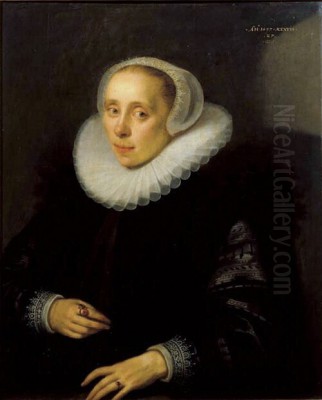
Gortzius Geldorp stands as a significant figure in the art history of the Low Countries during the late sixteenth and early seventeenth centuries. Active during a period of immense political and religious upheaval, Geldorp carved a distinct path for himself, primarily as a portrait painter. Though born in the Southern Netherlands and trained in the vibrant artistic hub of Antwerp, he spent the most productive and defining part of his career in the German city of Cologne. His work bridges the traditions of the Flemish Renaissance with the specific demands and tastes of his adopted city, leaving behind a legacy of finely crafted portraits and compelling history paintings.
Early Life and Artistic Formation in Antwerp
Gortzius Geldorp was born in 1553, most likely in Leuven, in the Duchy of Brabant, part of the Habsburg Netherlands. Some older sources mention Louvain (Leuven) or even Cologne, while others suggest Luxembourg, highlighting a degree of uncertainty that often surrounds artists of this period. His parentage remains obscure. What is clearer is his artistic education, which took place in Antwerp, the undisputed economic and cultural powerhouse of the region at that time.
Antwerp in the mid-to-late sixteenth century was a crucible of artistic innovation and production. Geldorp had the distinct advantage of training under two respected masters. Initially, he studied with Frans Francken the Elder (1542–1616), the patriarch of the prolific Francken family of painters, known for their small-scale cabinet pictures often featuring historical, mythological, or allegorical scenes crowded with figures. This apprenticeship would have exposed Geldorp to a strong tradition of figure painting and narrative composition.
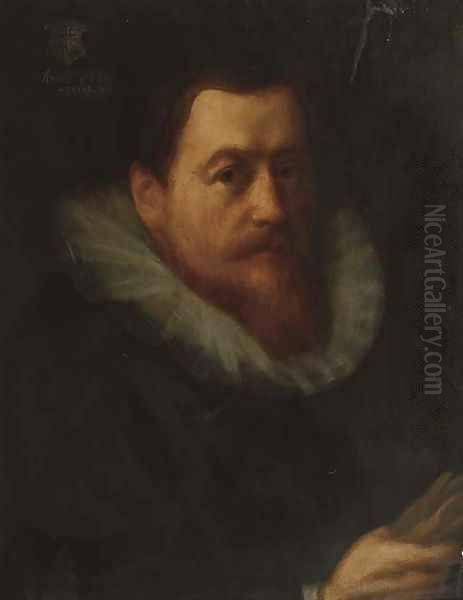
Subsequently, Geldorp became a pupil of Frans Pourbus the Elder (c. 1545–1581). Pourbus was himself a student of the great Frans Floris and had established a reputation as a leading portraitist and painter of religious scenes in Antwerp. His style was characterized by sharp observation, refined technique, and an elegant, somewhat formal presentation of his sitters, often drawn from the city's wealthy bourgeoisie and nobility. This training under Pourbus was arguably more decisive for Geldorp's future specialization in portraiture, instilling in him a focus on capturing likeness, rendering textures, and conveying the status of the sitter. The influence of Pourbus's meticulous realism and sophisticated palette can be discerned in Geldorp's later work.
The artistic environment of Antwerp during Geldorp's formative years was rich and diverse. He would have been aware of the works of established masters like Maarten de Vos, Ambrosius Francken I (Frans Francken the Elder's brother), and the legacy of painters like Pieter Bruegel the Elder, whose influence permeated Flemish art. The city was also a centre for printmaking, with workshops like that of Hieronymus Cock publishing engravings after designs by leading artists, disseminating styles and compositions widely. This dynamic atmosphere provided a fertile ground for a young artist to absorb various influences.
The Journey to Cologne: A Career Pivot
Geldorp's career took a decisive turn around 1579. This was a period marked by the intense turmoil of the Eighty Years' War, the Dutch Revolt against Spanish Habsburg rule. Religious conflict between Catholics and Protestants, coupled with political strife, made life and patronage precarious in the Southern Netherlands, particularly after the Spanish Fury in Antwerp (1576) and the subsequent period of Calvinist rule (1577-1585).
In 1579, Geldorp entered the service of Carlo d'Aragona Tagliavia (1530–1599), Duke of Terranova, a prominent Sicilian nobleman and Spanish diplomat. The Duke was involved in peace negotiations held in Cologne between the Spanish Crown and the rebellious provinces of the Netherlands. Geldorp accompanied the Duke's entourage to Cologne. While the peace talks ultimately failed, this journey proved pivotal for Geldorp. Instead of returning to the increasingly troubled Antwerp, he chose to remain in Cologne.
Cologne, an Imperial Free City, offered a different environment. Although predominantly Catholic, it maintained a degree of relative stability compared to the war-torn Netherlands. It was a major commercial and religious centre on the Rhine, with its own established patrician class and ecclesiastical patrons. For an artist like Geldorp, trained in the prestigious Antwerp school but perhaps seeking refuge or new opportunities, Cologne presented a viable alternative. He settled there and would remain for the rest of his life, becoming a citizen and integrating into the city's artistic and social fabric.
Portrait Painter to the Cologne Elite
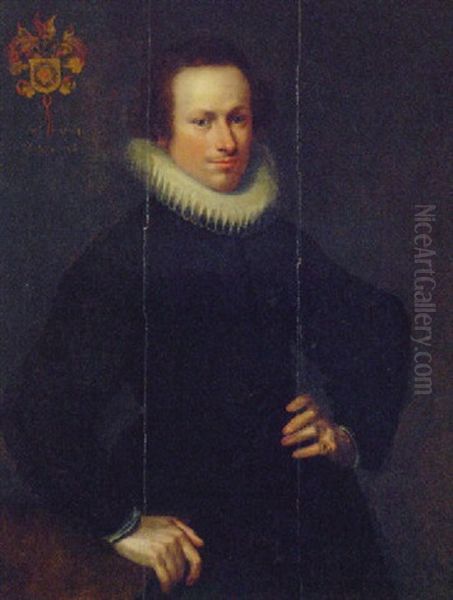
In Cologne, Gortzius Geldorp rapidly established himself as the leading portrait painter of his generation. He found favour among the city's wealthy merchants, patrician families, and civic leaders. His Antwerp training, particularly the refined realism inherited from Pourbus, distinguished his work from some of the more established local traditions, perhaps represented by the later works of the Bruyn family workshop (Bartholomäus Bruyn the Elder and his sons). Geldorp offered a style that was both detailed and lifelike, capable of conveying the dignity and status of his sitters with a Flemish flair.
His portraits from this period are characterized by careful attention to detail, particularly in the rendering of clothing, accessories, and facial features. He excelled at capturing the textures of rich fabrics – silks, velvets, intricate lace ruffs and cuffs – which were important markers of social standing. His palette is often rich and sonorous, though sometimes employing darker, more sober tones favoured in portraiture of the time. Figures are typically presented in three-quarter view, often against a plain dark background, focusing attention entirely on the sitter.
A significant number of Geldorp's portraits survive, estimated at around 70, many depicting members of prominent Cologne families like the Hardenraths and the von der Hagens. Often, these were created as pendants – matching portraits of husband and wife. A fine example is the Portrait of Hortensia del Prado (1599), wife of a Cologne merchant and art collector. The painting showcases Geldorp's skill in rendering the elaborate costume and jewellery, while also capturing a sense of the sitter's composed and dignified presence. Another notable work is the Portrait of Cathrina Vlenbergs (c. 1602). These works demonstrate his ability to meet the expectations of his clientele for accurate likenesses that also projected wealth and respectability.
Compared to some of his Antwerp contemporaries who might lean towards greater psychological dynamism, Geldorp's Cologne portraits often possess a certain reserved quality, perhaps reflecting the tastes of the city's elite or a more conservative local tradition. However, they are never stiff or lifeless; his sitters are rendered with a subtle naturalism and individuality. He successfully adapted his Flemish training to the specific context of Cologne patronage.
Analyzing Geldorp's Portrait Style
Geldorp's approach to portraiture synthesized elements from his training and the broader trends in Netherlandish art. The influence of Frans Pourbus the Elder is evident in the meticulous technique, the emphasis on accurate likeness, and the detailed rendering of costume. This detailed realism was a hallmark of Netherlandish painting tracing back to Jan van Eyck, but adapted here to the specific requirements of late 16th and early 17th-century portraiture.
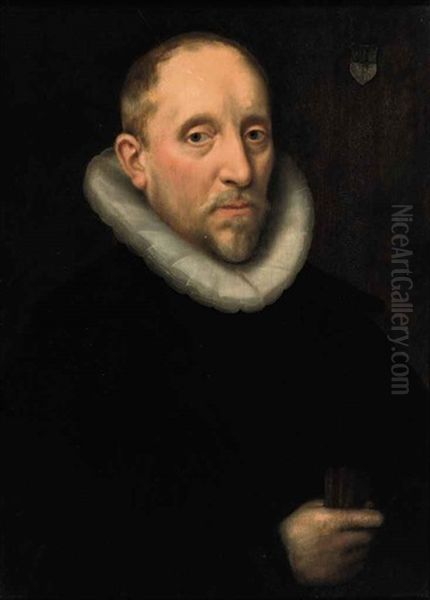
His compositions are generally straightforward, focusing on the sitter without distracting background elements. Lighting is typically used to model the face and hands clearly, highlighting the features and suggesting volume. While perhaps not as dramatically innovative in lighting as later Baroque masters like Rembrandt or even his contemporary Rubens in his portraits, Geldorp's use of light and shadow is effective and contributes to the sense of presence.
The rendering of fabrics is a particular strength. The complex, starched linen ruffs that were fashionable at the time are painted with painstaking care, capturing the intricate folds and translucent quality of the material. Similarly, the sheen of silk, the texture of velvet, and the glint of gold embroidery or jewellery are convincingly portrayed. This virtuosity not only demonstrated his technical skill but also served the primary function of the portrait: to record the sitter's appearance and affirm their social status.
While rooted in the tradition of his teachers, Geldorp's style also shows an awareness of international trends. The three-quarter pose and the focus on conveying status align with developments seen in court portraiture across Europe, influenced by artists like Antonis Mor (Anthonis Mor van Dashorst), who had worked for the Habsburg courts and whose style emphasized aristocratic poise and psychological presence. Geldorp's work, however, generally retains a slightly more solid, grounded quality compared to the sometimes more elongated elegance of Mannerist court portraiture.
Religious and Historical Themes
While best known for his portraits, Gortzius Geldorp was also active as a painter of religious and historical subjects, genres in which his Antwerp training would have provided a strong foundation. These works allowed him to engage with narrative composition and explore a wider range of emotional expression than typically found in formal portraiture.
Several religious paintings by Geldorp are known. The Last Supper (dated versions exist, e.g., c. 1576, possibly begun in Antwerp) demonstrates his ability to handle a complex multi-figure composition, arranging the apostles around the central figure of Christ in a way that conveys the drama and solemnity of the moment. His depiction adheres to traditional iconography but is rendered with the same attention to detail and solid figural style seen in his portraits.
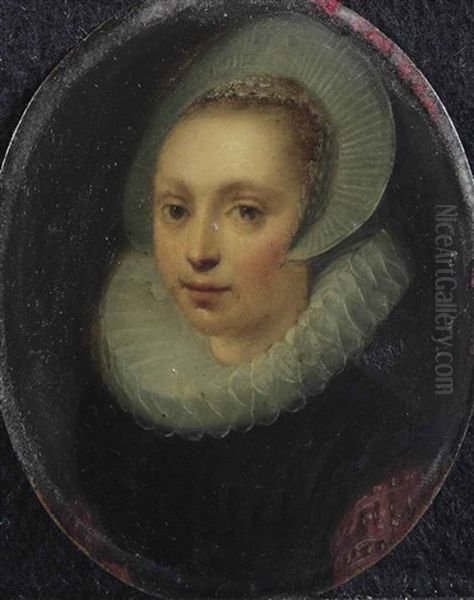
Another significant religious work is Christ on the Cross (versions exist, including one dated 1597-1603). Such themes were particularly relevant in Catholic Cologne during the era of the Counter-Reformation, which emphasized devotional imagery that could inspire piety and emotion. Geldorp's treatment likely focused on the suffering of Christ and the grief of the onlookers, rendered with clarity and pathos.
He also painted Old Testament scenes, such as Esther and Ahasuerus (c. 1612). This subject, depicting Queen Esther pleading with the Persian king Ahasuerus to save her people, was popular for its dramatic potential and its themes of courage and divine providence. Geldorp's interpretation likely focused on the interaction between the main figures, using costume and gesture to convey the narrative. Another work sometimes cited is Samuel Anointing Saul (or David), demonstrating his engagement with significant biblical narratives. His Luke the Evangelist (c. 1605) fits into a long tradition of depicting the authors of the Gospels.
In these history paintings, Geldorp employed a style consistent with his portraiture: solid, well-defined figures, careful rendering of textures and details, and clear storytelling. While perhaps not reaching the dynamic energy that would characterize the Baroque history paintings of Rubens (who was a generation younger), Geldorp's works in this genre are competent and reflect the prevailing tastes of the late Renaissance in Northern Europe. Artists like Otto van Veen in Brussels and Antwerp were working in a similar classicizing, narrative vein.
Workshop, Collaborations, and Influence
Like most successful artists of his time, Gortzius Geldorp likely maintained a workshop in Cologne to assist him in producing paintings, particularly for larger commissions or replicas of popular compositions. The extent of workshop participation in his surviving oeuvre is difficult to ascertain without technical examination, but it was standard practice.
One significant connection is through his son, Georg Geldorp (or George Geldorp, c. 1590/95–1665). Georg also trained as a painter, likely under his father in Cologne. However, Georg's career took a different path. He moved to London, probably by the early 1620s, and became active primarily as an art dealer and agent, although he did paint portraits as well. Georg played a notable role in the London art world, facilitating commissions and connections for major Flemish artists like Peter Paul Rubens and Anthony van Dyck during their visits or periods of work in England. He also had connections with later artists active in Britain, such as Peter Lely. This connection through his son extended the Geldorp name, albeit indirectly, into the mainstream of the European Baroque art scene.
Gortzius Geldorp may also have collaborated with printmakers, a common practice for painters seeking to disseminate their compositions to a wider audience. Some sources suggest connections or collaborations with engravers like Crispijn van de Passe the Elder, who was active in Cologne for a period around 1589-1611. Engravings after Geldorp's designs, particularly portraits or religious scenes, would have helped to spread his reputation beyond Cologne. The Wierix brothers were another family of prolific engravers active in Antwerp and Brussels whose work defined high-quality reproductive printmaking in the era.
Geldorp's influence within Cologne itself seems clear. As the city's preeminent portraitist for several decades, his style likely set a standard for other local artists. He was respected enough to be elected as a representative (Vierherr) of the painters' section within the relevant guild (likely the Schilderer-Gaffel) in Cologne, indicating his standing among his peers.
Later Years and Historical Assessment
Gortzius Geldorp continued to work actively in Cologne throughout the early 17th century. His reputation as a skilled and reliable painter of portraits and history subjects was well established. The exact date of his death is subject to some debate among art historians. While older sources often cite 1618, more recent scholarship, particularly based on archival evidence from Cologne, strongly suggests he died earlier, likely in 1616. He passed away in Cologne, the city where he had built his successful career over more than three decades.
Historically, Gortzius Geldorp occupies a specific and important place in the art of the period. He represents a successful transplantation of the highly developed Antwerp painting tradition, particularly in portraiture, to a major German artistic centre. His work demonstrates the adaptability of Flemish styles and the interconnectedness of art markets across the Rhine region.
While he may not have been an innovator on the scale of contemporaries like Hendrick Goltzius in Haarlem (known for his flamboyant Mannerism and brilliant draftsmanship) or later figures like Rubens and Van Dyck who ushered in the High Baroque, Geldorp excelled within his chosen domain. He provided the wealthy citizens of Cologne with portraits that met their needs for representation, status affirmation, and remembrance, executed with a high degree of technical skill and refined realism. His style can be seen as a solid continuation of the Netherlandish portrait tradition exemplified by artists like Adriaen Thomasz Key or his own master Pourbus, updated for the turn of the century but stopping short of the full dynamism of the Baroque.
His religious paintings, while less numerous or perhaps less central to his reputation today, show his competence in narrative composition and his participation in the broader currents of Counter-Reformation art. They provide valuable insights into the religious visual culture of Cologne at the time.
Geldorp's work is represented in major museums, including the Rijksmuseum in Amsterdam, the Wallraf-Richartz Museum in Cologne, and others, primarily in Germany and the Netherlands. His portraits remain valuable documents of the appearance and social aspirations of the Cologne elite around 1600, rendered by a skilled hand trained in one of Europe's leading artistic centres.
Conclusion: A Bridge Between Traditions
Gortzius Geldorp's life and work exemplify the complex artistic landscape of Northern Europe around 1600. Trained in the sophisticated environment of late 16th-century Antwerp under significant masters like Francken and Pourbus, he navigated the turbulent political and religious climate by relocating to Cologne. There, he became the city's most sought-after portrait painter, adapting his Flemish skills to the tastes of a German clientele. His legacy consists primarily of meticulously crafted portraits that offer a window onto the society of Cologne's ruling class, alongside competent religious and historical works. While perhaps overshadowed in grand narratives of art history by the giants of the Baroque who followed, Geldorp remains a crucial figure for understanding the regional developments in painting in the Lower Rhine area and the enduring strength of the Netherlandish portrait tradition during the transition from Renaissance to Baroque. His work stands as a testament to skill, adaptability, and the enduring power of the painted image to capture both likeness and status.